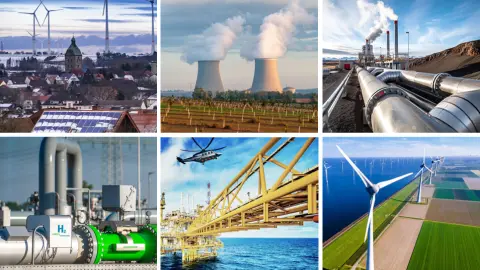Renewable Power: Growth calls for system improvement
The demand for renewable power is set to climb, driving more project development, especially in solar. To ensure the grid is compatible with this growth, the EU and US need to boost transmission capacity, enhance grid flexibility, and cut permitting backlogs. Trade protection measures can lead to more re-routing and higher supply chain costs
The demand for renewable electricity is expected to increase substantially in the future. In the US, corporate power purchasing power agreements (PPAs) are leading the growth, especially from data centres. The industry's rapid adoption of artificial intelligence (AI) is adding tremendous electricity demand, and purchases of solar and wind capacity by sustainability-conscious data centres increased to 34GW last year, contributing to half of all renewable capacity contracted to corporations. It is true that one executive order from Trump’s inauguration calls for an end to the Biden administration's “EV mandate,” but this would not materially affect short-term electricity demand growth as EV electricity consumption is only a fraction of the country's total now.
In the EU, the engine for renewable power demand growth has largely been the RePowerEU plan, with a mandate that 42.5% of the bloc’s electricity needs will be drawn from renewables by 2030. This has led to more renewable auctions and power purchasing. Plus, the electrification-led energy transition across the transport, residential, and industrial sectors signals a structural change towards renewable energy power usage.
But will this jump in the need for renewable power be met? Which elements are driving – or complicating – the renewable power market? In this article, we focus on solar and wind power and identify three key trends for 2025.
Call 1: More capacity in 2025 – but wind outlook varies by region
We expect renewed momentum for developers to continue their efforts to keep up with the demand increase in 2025. This is driven by competitive costs, sustained corporate renewable power purchasing, renewable auctions, and existing government funding. Capacity building will continue to translate into increased renewable power generation in 2025, as most projects that are well underway with secured grid connections are unlikely to see disruption. We foresee the share of solar and wind in the total power mix likely growing from 28% in 2024 to 30% in 2025 in the EU, and from 16% to 18% during the same period in the US.
Solar and wind's share in total power generation continues to climb in 2025

However, it is worth noting that in the EU, renewable capacity and generation growth will likely come from both wind and solar sources, while the US market will be predominantly driven by solar.
In Europe, we anticipate that the upcoming Clean Industrial Deal will position renewables as a strategy for businesses to become greener and remain competitive by reducing power costs. This is achieved through Power Purchase Agreements (PPAs) from renewables, which offer lower power costs compared to market prices driven by gas-fired power plants that run on costly LNG.
In the US, policy disruption is already underway for the wind industry. As expected, offshore wind leasing has been temporarily paused. More surprising is the temporary pause on new and renewed approvals, permits, and loans for both onshore and offshore wind projects. While there are not yet overarching measures on existing permits, Trump's order does call for a review of wind permitting procedures in general. All this will deal a major blow to the wind industry, especially offshore wind, leading to a plunge in market confidence and slowed project development. We can expect legal challenges to this order; eventually, we could expect much stricter permitting criteria for new projects, with existing permits being assessed on a case-by-case basis. Solar has not been targeted so far, which was not surprising given a more systematically competitive cost profile and less perceived opposition. (We also hold a positive view on biofuels as it has been included in Trump's 'Unleashing American Energy' executive order to support domestic energy development. And we are cautiously positive about technology-neutral clean electricity tax credits under the Inflation Reduction Act, because of the potential benefit to more technologies including nuclear.)
Admittedly, the offshore wind industry has already faced challenges in both the US and Europe. In 2023, the industry was adversely impacted as the large-scale nature of projects and substantial capital investments collided with high inflation, rising interest rates, and supply chain disruptions. Macro conditions have since moderated, and auction re-designs are underway, but the sector’s recovery has been slow. In the US, notable project cancellations in 2024 included those from Ørsted, GE Vernova, Equinor, and BP. In the EU, Vattenfall exited an offshore bid after winning it, while a Denmark offshore tender in the North Sea received no bids. The offshore wind levelised cost of energy (LCOE) has fallen over the past few years but remains more elevated than onshore wind and solar.
However, we still see positive potential for offshore wind in the EU and this is largely driven by government policy support. Many countries, including Germany, the Netherlands and Denmark, will continue to have government support in terms of revenue contracts, grid connection, and tender issuing (there are examples of successful tenders too). We do not therefore foresee tenders becoming less attractive for developers in Europe. Instead, we expect developers to prioritise certain tenders over others and avoid submitting subsidy-free bids.
With the market dynamics presented above, we maintain a positive outlook for solar in 2025, with the wind market less complicated by policy in Europe.
Call 2: Expanding the focus from renewables buildout to grid enhancement
The climbing demand for renewable electricity is keeping developers busy building new plants. But there is a growing threat that grids in the EU and the US may not have enough capacity or flexibility to deliver all the renewable electricity while maintaining stability. Timely actions to improve the grid have therefore become important.
Firstly, more transmission lines are needed to send renewable electricity from generation sites, which are often in remote areas, to urban areas where demand is. This need has grabbed the attention of governments. In the US, the Infrastructure Law and Inflation Reduction Act (IRA) have allocated billions of dollars to expand the grid. In 2024, a cumulative 28,275 miles of transmission lines were under development/planning, visibly higher than previous averages. As for Trump, we think the new administration will be conscious of addressing grid insufficiency, leading to more power capacity to be connected to the grid, including solar and wind.
Across the Atlantic, the EU laid out an Action Plan in 2023 to facilitate new grid projects and enhance access to finance, among others. Admittedly, project developers can find it hard to claim funding as resources are dispersed across EU and state-level programmes. But more improvements in EU policy efficiency are anticipated as the bloc enters the implementation phase of the Draghi report.
Secondly, not only is expansion needed but the existing grid itself needs to be enhanced for higher efficiency and flexibility. Regarding transmission lines, hardware and software improvements can already increase transmission capacity, meanwhile allowing more accurate real-time monitoring and adjustments. Regarding grid flexibility, more efforts are being taken to better manage electricity demand, including peak demand shaving, virtual power plants, and so on. Another key method of enhancing grid flexibility is through energy storage (discussed in closer detail later). Italy is to become the first country among the EU and US to host energy storage auctions starting in 2025 to enhance the grid. This mechanism could potentially be replicated in other countries.
Finally, permitting reform is needed for approving grid-related projects to ensure the grid is improved at a speed matching that of renewable projects. In Germany, onshore wind projects still needed to wait for around two years to be connected to the grid after project approvals from 2018-2022, up from one year in 2011-2017. In response, Germany implemented an EU-enabled Emergency Regulation, which allows special measures to be taken if energy supply difficulties prevail. The country has since then experienced substantial grid project permitting growth, with an estimated 1,772 kilometres of new transmission lines approved by July 2024. Further implementation of the EU Renewable Energy Directive III's reform on permitting processes will also be helpful.
In short, we are seeing an expansion of focus from capacity buildouts to addressing systematic bottlenecks so that the renewable industry can continue growing to its full potential.
Increased focus on long-duration energy storage
Despite the massive scaling up of solar and wind, they still face a fundamental challenge: intermittency. Energy storage comes in as a critical solution. Existing technologies such as lithium-ion batteries provide short-duration storage solutions, but the dispatching time (less than four hours) is too short to be effective. That is why long-duration energy storage (LDES) – defined differently across countries but generally refers to technologies with over eight hours of dispatching time – is now gaining traction.
Among LDES technologies, only pumped storage hydropower (PSH, with 4-10 hours of dispatching time) is commercially available. The US currently has about 22GW of PSH capacity, while Europe hosts roughly 46GW, with more development underway in both places. But even PSH's dispatching length is still not high enough. Longer-duration storage technologies are emerging, including compressed air energy storage, liquid air energy storage, thermal heat storage, and aqueous electrolyte flow batteries. These technologies are still on the way to commercialisation, requiring significant policy and capital support.
A positive aspect to note here is that governments, developers, and investors are keen to get a head start in emerging LDES technologies, boosting demand and project pipelines. California Public Utilities Commission plans to take bids in 2026 to procure 2GW of LDES from 2031-2037. Germany is planning for a 500MW LDES tender for 2025 and 2026. Almost 6GW of capacity is likely to have been added in 2024; this trend is expected to continue in 2025 with stacking tender plans and planned projects.
Call 3: Western protectionism and China’s production overseas to shake up the market
Both the US and the EU are prioritising building the domestic renewable power supply chain. The EU has rolled out the Net-Zero Industry Act, forming industrial hubs and promoting a supportive regulatory environment for more investment in domestic manufacturing. In the US, the IRA and Infrastructure Law offers financial support for solar and wind manufacturing, and it is possible that the Trump administration may add more domestic content clauses, such as the requirement for a higher percentage of equipment parts to be produced in the US.
Still, the full impact of these policies is set to be felt in the long term. For now, China is maintaining its dominance in solar and wind manufacturing and it remains difficult for the EU and the US to shake off the China supply chain habit.
China's dominance in solar and wind manufacturing
Solar and wind production capacity by origin

Large production capacity in China has contributed to low costs and prices. For example, Chinese wind turbines offer a 32% price discount compared to their Western counterparts, and Chinese manufacturers are increasingly targeting Western markets due to fierce domestic competition. The situation is similar for other cleantech solutions, including solar panels. This has led to rising protectionism against China’s dominance through trade policy.
In the US, former president Joe Biden continued the path forged by his two predecessors and raised tariffs on Chinese solar panel equipment to over 300%. US imports of Chinese solar equipment have consequently collapsed to almost zero, but the country has instead been importing from Southeast Asia, where China has ramped up manufacturing. This has prompted Biden to impose tariffs of up to 271% on solar imports from Vietnam, Thailand, Cambodia and Malaysia. With Trump’s hawkish stance on China, we do not expect any easing of these tariffs; we may even see them being ramped up in the case of an exacerbated trade war.
These measures could lead China to re-route trades within Southeast Asia. Chinese solar companies were already building production capacity in countries such as Indonesia and Laos. Trade re-routes and lucrative tax credits from the IRA can be buffers to supply chain shocks in the US, but trade tensions can still result in higher equipment and project costs. Trump’s proposed 60% tariff on all imported Chinese goods will further add complications to developers’ access to low-cost materials.
Meanwhile, Chinese solar companies are looking to manufacturing in the US and bypass the tariffs. Among them, Chinese company Longi and US company Invenergy formed a joint venture (JV) to build a 5GW solar module factory in Ohio. While such projects can help the US build the domestic supply chain, they have also drawn security-related concerns. But we think the majority stake held by US counterparts in this type of JV – as well as the economic benefit brought to the industry – could give these projects a lifeline.
In Europe, there are currently no tariffs on imports of solar or wind equipment, though the EU has just finalised a tariff of up to 48% on Chinese EVs, and the bloc is also undergoing an investigation into any potential unfair government subsidies on Chinese wind turbines (the EU dropped investigations on Chinese companies’ biddings of two solar tenders after they withdrew applications). In a more hawkish scenario, the EU might align with the US and start imposing tariffs on Chinese renewable equipment, most likely wind turbine parts. This would result in at least an initial shock among EU developers, as they remain highly dependent on direct Chinese exports. Chinese renewable power companies are also trying to open factories in Europe to avoid potential tariffs, and we foresee the country doubling down on this effort in 2025.
The need to match supply with mounting demand for renewable power has confirmed our view on another year of strong growth in solar and wind deployment in the US and the EU. It has also called the industry’s attention to ensure the grid has enough capacity and is effective in bringing on more renewable electricity. For solar and wind capacity to grow resiliently in the future, transmission line efficiency, demand response, and power storage are all crucial. And as China continues to dominate the renewable manufacturing supply chain, it has grown increasingly important for other countries to implement competitive industrial policies that facilitate investment and innovation. Trade protectionism can shield domestic companies from foreign competition, but there can be a short-term cost to pay.
This publication has been prepared by ING solely for information purposes irrespective of a particular user's means, financial situation or investment objectives. The information does not constitute investment recommendation, and nor is it investment, legal or tax advice or an offer or solicitation to purchase or sell any financial instrument. Read more
Download
Download article
22 January 2025
Energy Outlook 2025: Growth amid challenges This bundle contains 7 Articles
